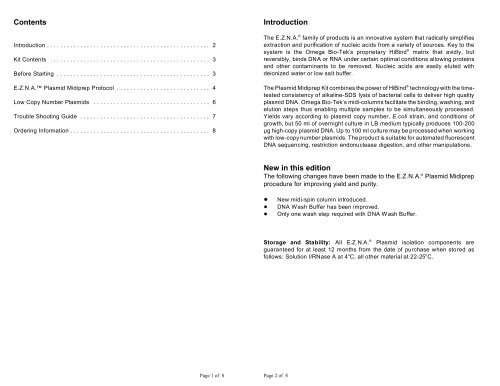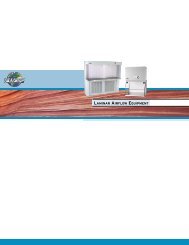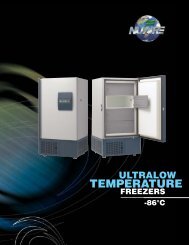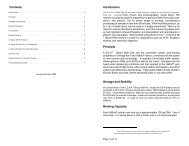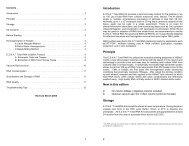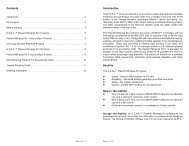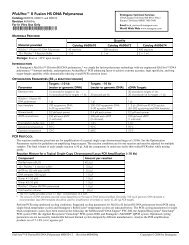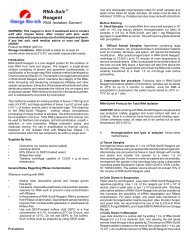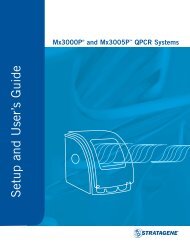E.Z.N.A. ® plasmid midiprep kit Protocol (PDF Version)
E.Z.N.A. ® plasmid midiprep kit Protocol (PDF Version)
E.Z.N.A. ® plasmid midiprep kit Protocol (PDF Version)
Create successful ePaper yourself
Turn your PDF publications into a flip-book with our unique Google optimized e-Paper software.
Contents<br />
Introduction ................................................. 2<br />
Kit Contents ................................................ 3<br />
Before Starting .............................................. 3<br />
E.Z.N.A. Plasmid Midiprep <strong>Protocol</strong> ............................ 4<br />
Low Copy Number Plasmids ................................... 6<br />
Trouble Shooting Guide ....................................... 7<br />
Ordering Information .......................................... 8<br />
Introduction<br />
The E.Z.N.A. ® family of products is an innovative system that radically simplifies<br />
extraction and purification of nucleic acids from a variety of sources. Key to the<br />
system is the Omega Bio-Tek’s proprietary HiBind ® matrix that avidly, but<br />
reversibly, binds DNA or RNA under certain optimal conditions allowing proteins<br />
and other contaminants to be removed. Nucleic acids are easily eluted with<br />
deionized water or low salt buffer.<br />
The Plasmid Midiprep Kit combines the power of HiBind ® technology with the timetested<br />
consistency of alkaline-SDS lysis of bacterial cells to deliver high quality<br />
<strong>plasmid</strong> DNA. Omega Bio-Tek’s midi-columns facilitate the binding, washing, and<br />
elution steps thus enabling multiple samples to be simultaneously processed.<br />
Yields vary according to <strong>plasmid</strong> copy number, E.coli strain, and conditions of<br />
growth, but 50 ml of overnight culture in LB medium typically produces 100-200<br />
g high-copy <strong>plasmid</strong> DNA. Up to 100 ml culture may be processed when working<br />
with low-copy number <strong>plasmid</strong>s. The product is suitable for automated fluorescent<br />
DNA sequencing, restriction endonuclease digestion, and other manipulations.<br />
New in this edition<br />
The following changes have been made to the E.Z.N.A. ® Plasmid Midiprep<br />
procedure for improving yield and purity.<br />
! New midi-spin column introduced.<br />
! DNA Wash Buffer has been improved.<br />
! Only one wash step required with DNA Wash Buffer.<br />
Storage and Stability: All E.Z.N.A. ® Plasmid isolation components are<br />
guaranteed for at least 12 months from the date of purchase when stored as<br />
follows: Solution I/RNase A at 4 o C, all other material at 22-25 o C.<br />
Page 1 of 8<br />
Page 2 of 8
Kit Contents<br />
E.Z.N.A. ® Plasmid Midiprep Kit<br />
E.Z.N.A. ® Plasmid Midiprep <strong>Protocol</strong><br />
Product Number D6904-00 D6904-03 D6904-04<br />
Purifications 2 25 100<br />
HiBind ® DNA Midi Columns 2 25 100<br />
15 ml collection tubes 2 25 100<br />
Solution I 5 ml 35 ml 150 ml<br />
Solution II 5 ml 35 ml 150 ml<br />
Solution III 5 ml 50 ml 200 ml<br />
Buffer HB 8 ml 80 ml 350 ml<br />
Wash Buffer Concentrate 2 ml 25 ml 2 x 100 ml<br />
RNase A, Concentrate 25 l 150 l 600 l<br />
Instruction Booklet 1 1 1<br />
Before Starting<br />
Briefly examine this booklet and become familiar with each step. Prepare all<br />
components and have the necessary materials ready before starting.<br />
Supplied By<br />
User:<br />
IMPORTANT<br />
High speed centrifuge capable of 12,000 x g<br />
Swing-bucket centrifuge capable of 5000 x g with<br />
adaptor for 15 and 50ml tube.<br />
Sterile 15 & 50ml centrifuge tubes. (Falcon® tubes<br />
recommended.)<br />
High speed centrifuge tubes (polycarbonate or Corex®)<br />
Sterile deionized water (or TE buffer)<br />
Absolute (95%-100%) ethanol<br />
1. Add vial of RNase A to bottle of Solution I provided.<br />
Store at 4 o C.<br />
2. DNA Wash Buffer Concentrate is to be diluted with<br />
absolute ethanol as follows:<br />
D6904-00 Add 8 ml 100% ethanol<br />
D6904-03 Add 100 ml 100% ethanol<br />
D6904-04 Add 400 ml 100% ethanol per bottle<br />
Store diluted DNA Wash Buffer at room temperature<br />
Note: All steps must be carried out at room temperature.<br />
1. Culture volume: innoculate 50 ml LB/ampicillin (50 g/ml) medium placed<br />
in a 250 ml culture flask with E.coli carrying desired <strong>plasmid</strong> and grow at<br />
37C with agitation for 12-16 h.<br />
It is strongly recommended that an endA negative strain of E.coli be used<br />
for routine <strong>plasmid</strong> isolation. Examples of such strains include DH5 ® and<br />
JM109 ®.<br />
2. Pellet bacteria by centrifugation at 4,000 -5000 x g for 10 min at room<br />
temperature.<br />
3. Decant or aspirate medium and discard. To the bacterial pellet add 1.25 ml<br />
Solution I/RNase A. Resuspend cells completely by vortexing and/or<br />
pipetting. Complete resuspension of cell pellet is vital for obtaining good<br />
<strong>plasmid</strong> yields.<br />
4. Transfer cell suspension to a 15-30 ml centrifuge tube capable of<br />
withstanding 12,000 x g (screw-cap polycarbonate or Corex ® glass tubes will<br />
suffice). Add 1.25 ml Solution II, cover, and gently mix by inverting and<br />
rotating tube 7-10 times to obtain a cleared lysate. A 5 min incubation at<br />
room temperature may be necessary. Avoid vigorous mixing as this will<br />
shear chromosomal DNA and lower <strong>plasmid</strong> purity. Prolonged incubation<br />
may lead to nicking of <strong>plasmid</strong> DNA. (Store Solution II tightly capped when<br />
not in use.)<br />
5. Add 1.75 ml Solution III, cover, and gently mix by inverting several times until<br />
a flocculent white precipitate forms. Centrifuge at 12,000 x g for 15 minutes<br />
at room temperature to pellet the cellular debris and genomic DNA.<br />
6. CAREFULLY aspirate and apply the clear supernatant to a HiBind ® DNA Midi<br />
column assembled in an 15 ml collecting tube making sure that no cellular<br />
debris is carried over. The Midi column has a maximum capacity of 4.5 ml.<br />
Centrifuge 5 min at 5,000-8,000 x g at room temperature to completely pass<br />
lysate through column. Discard the flow-through and reuse the collecting<br />
tube in step 7.<br />
IMPORTANT: This and all subsequent steps must be performed using<br />
a centrifuge capable of at least 4,000 x g. Ensure that an appropriate<br />
rotor adaptor is in place to prevent damage to the collecting tube.<br />
7. Add 3 ml Buffer HB to the Midi column and centrifuge 5 min at 5,000-8,000<br />
x g as above. This step ensures that residual protein contamination is<br />
removed and must be included for downstream applications requiring high<br />
quality DNA. Discard flow-through liquid and reuse the collecting tube in the<br />
next step.<br />
Page 3 of 8<br />
Page 4 of 8
8. Wash the column by adding 4 ml of DNA W ash Buffer diluted with ethanol.<br />
Centrifuge 5 min at 5,000-8,000 x g at room temperature and discard flowthrough.<br />
Note: Wash Buffer Concentrate must be diluted with absolute ethanol before use. See<br />
label for directions. If refrigerated, Wash Buffer must be brought to room temperature<br />
before use.<br />
Low Copy Number Plasmids<br />
Such <strong>plasmid</strong>s can sometimes yield as little as 0.1 g DNA per 1 ml culture. To<br />
increase yields, innoculate up to 100 ml LB medium and incubate at 37 o C for 12-<br />
16 h in a 500 ml flask. Adequate aeration can be achieved with a shaker set to<br />
220-250 rpm. Follow the protocol above (page 4), ensuring that in step 3, the<br />
cells are completely resuspended in Solution I/RNase A.<br />
9. Optional step: repeat wash step with another 4 ml DNA Wash Buffer.<br />
Centrifuge as above and discard fluid.<br />
10 Centrifuge the empty capped column for 10 min at 5,000 x g to dry the<br />
column matrix. Do not skip this step - it is critical for removing traces of<br />
ethanol that may otherwise interfere with downstream applications.<br />
Remove any traces of ethanol from the column using a pipette.<br />
11. Place column into a clean 15 ml centrifuge tube. Add 1.0-1.5 ml (depending<br />
on desired concentration of final product) sterile deionized water (or TE<br />
buffer) directly onto the column matrix. Allow column to sit 2 min at room<br />
temperature. Centrifuge 5 min at 5,000 x g to elute DNA. This represents<br />
approximately 70% of bound DNA. An optional second elution will yield any<br />
residual DNA, though at a lower concentration. Alternatively, a second<br />
elution may be performed using the first eluate to maintain a high DNA<br />
concentration. Also, preheating the water to 70 o C prior to elution may<br />
significantly increase yields.<br />
If the column was NOT completely dried (step 10.) prior to elution, some<br />
ethanol from DNA Wash Buffer might be carried over to the eluted DNA and<br />
it is necessary to precipitate the <strong>plasmid</strong> DNA for final clean-up. To do so<br />
add sodium acetate to the eluate to a final concentration of 0.3 M followed<br />
by 2X volumes of absolute ethanol. Vortex to mix and centrifuge at 10,000<br />
x g for 10 min. Wash the DNA pellet once with 5-10 ml 70% ethanol and<br />
centrifuge again at 10,000 x g for 10 min. Decant and discard supernatant<br />
and air-dry pellet. Finally resuspend DNA pellet in 100 l-200 l sterile<br />
deionized water or TE buffer.<br />
14. Yield and quality of DNA: determine the absorbance of an appropriate<br />
dilution (10- to 20-fold) of the sample at 260 nm and then at 280 nm. The<br />
DNA concentration is calculated as follows:<br />
DNA concentration = Absorbance 260<br />
× 50 × (Dilution Factor) g/ml<br />
High copy number <strong>plasmid</strong>s generally yield up to 200 g of DNA from 50 ml<br />
culture. The ratio of (Absorbance 260<br />
)/(Absorbance 280<br />
) is an indication of nucleic<br />
acid purity. A value greater than 1.8 indicates > 90% nucleic acid. Alternatively,<br />
quantity (as well as quality) can sometimes best be determined by agarose<br />
gel/ethidium bromide electrophoresis by comparison to DNA samples of known<br />
concentrations. Typically, the majority of the DNA eluted is in monomeric<br />
supercoil form, though concatamers may also be present.<br />
Page 5 of 8<br />
Page 6 of 8
Trouble Shooting Guide<br />
Problem Likely Cause Suggestions<br />
Low DNA yields Poor cell lysis Only use LB or YT medium containing<br />
ampicillin. Do not use more than 50 ml<br />
with high copy <strong>plasmid</strong>s.<br />
Cells may not be dispersed adequately<br />
prior to addition of Solution II. Vortex<br />
cell suspension to completely disperse.<br />
Ordering Information<br />
PRODUCT NO. PRODUCT NAME DESCRIPTION<br />
E.Z.N.A. ® PLASMID MINIPREP SYSTEM<br />
D6942-01/02<br />
D6943-01/02<br />
D6944-01/02<br />
PLASMID MINIPREP KIT I<br />
ISOLATION OF UP TO 30G<br />
PLASMID IN 15 MINUTES<br />
Bacterial culture<br />
overgrown or not<br />
fresh.<br />
Low copy-number<br />
<strong>plasmid</strong> used<br />
Increase incubation time with Solution II<br />
to obtain a clear lysate.<br />
Solution II if not tightly closed, may need<br />
to be replaced. Prepare as follows: 0.2<br />
N NaOH, 1% SDS.<br />
Do not incubate cultures for more than<br />
16 hr at 37 o C. Storage of cultures for<br />
extended periods prior to plasm id isolation is<br />
detrimental.<br />
Such <strong>plasmid</strong>s may yield as little as<br />
0.1g DNA from a 1 ml overnight<br />
culture. Increase culture volume to 100<br />
ml.<br />
D6945-01/02<br />
D6946-01/02<br />
D6947-01/02<br />
D7042-01/02<br />
D7043-01/02<br />
D7045-01/02<br />
D7046-01/02<br />
PLASMID MINIPREP KIT II<br />
HIGH PERFORMACE PLASMID<br />
MINIPREP KIT I<br />
HIGH PERFORMACE PLASMID<br />
MINIPREP KIT II<br />
E.Z.N.A. ® PLASMID MIDI/MAXI ISOLATION SYSTEM<br />
ISOLATION OF UP TO 70G<br />
PLASMID IN 15 MINUTES<br />
ISOLATION OF UP TO 30G<br />
PLASMID FROM END A+<br />
BACTERIAL IN 25 MINUTES<br />
ISOLATION OF UP TO 70G<br />
PLASMID FROM END A+<br />
BACTERIAL IN 25 MINUTES<br />
No DNA eluted.<br />
High molecular<br />
weight DNA<br />
contamination of<br />
product.<br />
DNA Wash Buffer<br />
Concentrate not<br />
diluted with absolute<br />
ethanol.<br />
Over mixing of cell<br />
lysate upon addition of<br />
Solution II.<br />
Prepare Wash Buffer Concentrate as<br />
instructed on the label.<br />
Do not vortex or mix aggressively after<br />
adding Solution II. Adequate mixing is<br />
obtained by simply inverting and rotating<br />
tube to cover walls with viscous lysate.<br />
D6904-01/02 PLASMID MIDIPREP KIT MIDIPREPS IN SPIN COLUMN<br />
FORMAT. YIELD UP TO 200G<br />
PLASMID<br />
D6905-01/02<br />
FASTFILTER PLASMID<br />
MAXIPREP KIT<br />
30 MINUTES PLASMID MAXI<br />
PREPARATION WITH<br />
FASTFILTER UNITE. YIELD UP<br />
TO 0.2 G PLASMID<br />
Optical densities<br />
do not agree with<br />
DNA yield on<br />
agarose gel.<br />
RNA visible on<br />
agarose gel.<br />
Plasmid DNA<br />
floats out of well<br />
while loading<br />
agarose gel<br />
Plasmid DNA will<br />
not perform in<br />
downstream<br />
application<br />
Trace contaminants<br />
eluted from column<br />
increase A 260 .<br />
RNase A not added to<br />
Solution I.<br />
Ethanol not completely<br />
removed from column<br />
following wash steps.<br />
Traces of ethanol<br />
remain on column<br />
prior to elution.<br />
Make sure to wash column as instructed<br />
in steps 7-9. Alternatively, rely on<br />
agarose gel/ethidium bromide<br />
electrophoresis for quantization.<br />
Add 1 vial of RNase to each bottle of<br />
Solution I.<br />
Centrifuge column as instructed in step<br />
10 to dry .<br />
The column must be washed with<br />
absolute ethanol (step 10) and dried<br />
before elution. Ethanol precipitation may<br />
be required following elution.<br />
D6922-01/02 PLASMID MAXIPREP KIT MAXIPREPS IN SPIN COLUMN<br />
FORMAT. YIELD UP TO 1MG<br />
PLASMID<br />
D6924-01/02<br />
D7004-01/02<br />
FASTFILTER PLASMID<br />
MAXIPREP KIT<br />
HIGH PERFORMACE PLASMID<br />
MINIPREP KIT<br />
E-Z 96 ® PLASMID ISOLATION SYSTEM<br />
D1097-01/02<br />
FASTFFILTER® 96 WELL<br />
PLASMID KIT<br />
30 MINUTES PLASMID MAXI<br />
PREPARATION WITH<br />
FASTFILTER UNITE. YIELD UP<br />
TO 1MG PLASMID<br />
ISOLATION OF UP TO 200G<br />
PLASMID FROM END A+<br />
BACTERIAL STRAINS.<br />
ISOLATION OF PLASMID IN 96<br />
WELL FORMAT WITH LYSATE<br />
CLEARANCE PLATE<br />
Page 7 of 8<br />
Page 8 of 8


